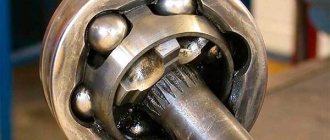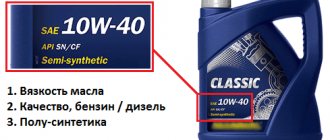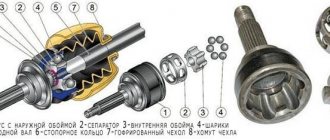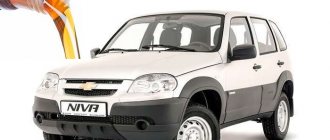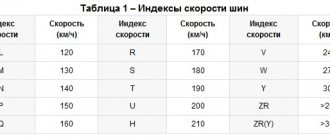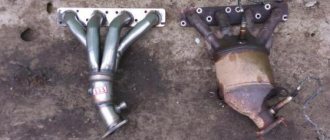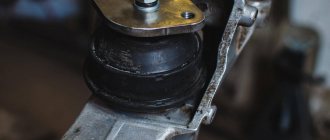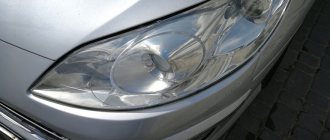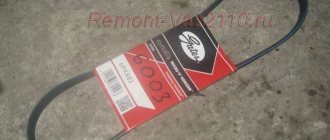Bearings are very common and well-known components used in various equipment, technology, and cars. Naturally, during operation they are exposed to various loads, speeds, and temperature changes, so without good maintenance, parts quickly fail and the question of replacing them arises.
Using lubricant, you will significantly extend the life of parts, which means reducing financial costs and saving your family budget. It seems so simple: take it, put in the lubricant and that’s it - however, you can’t take any lubricant and use it; first you need to decide on the type of recommended material and take into account the amount of filling. Next, we will look at the types and markings of lubricants, name the best ones and tell you how to choose the necessary material.
Lubricant requirements for wheel bearings
High-quality lubricant for wheel bearings must meet a number of requirements:
- Do not spread at high temperatures: in summer, during the daytime, the asphalt warms up to +70 °C, and with increasing loads on the bearing assembly, the temperature can reach +140 °C or more
- Do not thicken or harden at subzero temperatures: otherwise the shear force will increase, the balls or rollers in the bearings will go into sliding friction, which will lead to increased wear and the formation of scuffing
Ideally, the lubricant should maintain its performance characteristics at temperatures from -40 °C (possibly lower) to +140 °C.
- Do not wash off with water that enters the unit from the road surface: washing out the lubricant threatens the spread of corrosion.
- Have optimal viscosity in order to maintain its structure under the influence of high speeds, temperatures and loads, ensure effective lubrication and heat removal.
- Be resistant to various chemicals (reagents, fuel, oil), neutral to rubbers and plastics - so as not to destroy oil seals and anthers
Currently, lithium and molybdenum greases are most often used for wheel bearings. Let's take a closer look at these groups.
Lithium greases
The most common and widely used not only for servicing wheel bearings, but also other vehicle components. Materials based on mineral, synthetic and semi-synthetic base oils thickened with lithium soap or lithium complex.
Lithium greases have a long service life and a fairly affordable price. They operate under loads of up to 2800 N, protect components from corrosion, are not washed out by water, and have fairly high anti-wear and extreme pressure properties.
Other properties of these lubricants depend on the characteristics of the base oil. For example, silicone lithium greases have a low coefficient of friction and high dielectric properties and are resistant to aggressive chemicals. Materials based on essential synthetic oils can withstand very high speeds (over 1,300,000 mm*rpm) and also have noise-reducing abilities.
Lubricants based on polyalphaolefin (PAO) oils have very low pour points, are characterized by low coking, high thermal stability, and oxidation resistance.
In complex lithium greases, the base oil is thickened with soaps of lithium salts of acetic, adipic, azelaic and other acids. They are characterized by a wider operating temperature range, greater resistance to water, high mechanical stability and reduced oil separation.
Molybdenum lubricants
Lubricants with molybdenum disulfide (MoS2) as an anti-friction additive. Just like lithium, they can be mineral, synthetic and semi-synthetic.
Molybdenum disulfide particles form an additional lubricating layer on the surfaces of parts, which protects them from abrasive wear, scuffing and corrosion.
If the base oil evaporates, MoS2 takes over the lubricating function, and the lubricant begins to work as an emergency lubricant.
Molybdenum lubricants have a high load-bearing capacity and can operate under very heavy loads. As a rule, they are laid for the entire service life of the wheel bearing.
The disadvantage of molybdenum materials is that with prolonged exposure to water, abrasive particles are formed in them, which negatively affect the condition of the bearings. Therefore, if their tightness is compromised, the lubricant needs to be replaced.
Top quality copper lubricants
Today, copper-based lubricants, which have their own advantages and disadvantages, have also proven themselves well. This rating of the best copper oils, compiled on the basis of the same user reviews, will help you understand these nuances.
ASTROhim
Price – 149 rub. for 140 ml
If there is no unnecessary need to buy a large volume, then this option is optimal, since the bottle contains only 140 ml of orange lubricant. Moreover, thanks to its copper composition, the sample can easily withstand heating up to 1100 degrees at a minimum temperature of -30 C.
versatility, allowing the lubricant to find many applications, including dismantling rusted fasteners and restoring mechanisms to working condition after they have become corrosive;
low consumption despite the small volume;
high degree of adhesion and good moisture-proof properties;
affordable price tag.
lack of a long thin spout for treating hard-to-reach areas;
after opening the bottle and after a long break in use, the nozzle may become clogged, requiring cleaning.
MANNOL
Price – 215 rub. for 50 ml
Far from being the most affordable option, but with excellent technical characteristics. Thus, the lubricant does not slide, does not separate, does not mix with water, serving as a reliable water-repellent protection, and is not afraid of critical temperatures with sudden changes, easily withstanding an impressive range from -30 to 1100 C.
high-quality heat-resistant copper-based paste;
ease of use - the lubricant is easily applied to the surface being treated, remaining on it throughout its entire service life.
packaging in the form of a tube, which is always inferior to a bottle, and even does not have an ergonomic nozzle in the form of an elongated spout, which is why you have to look for aids for intermediate squeezing;
clearly overpriced.
Bizol Copper+ L54
Price – 487 rub. for 400 ml
If a small volume is clearly not enough, then it’s worth taking a closer look at this option, especially since it won’t break the bank and copes well with basic tasks. This multi-purpose lubricant is ideal for treating brake pads, various fasteners and the exhaust system as a whole.
high-quality grip and operation at maximum temperatures;
the ability to regulate the direction of the lubricating jet;
protection against moisture, rust and biting;
resistance to meteorological conditions;
compatibility with various synthetic compounds.
The price tag often changes, although initially the cost of the lubricant can hardly be called high, much less exorbitant.
G-Power
Price – 260 rub. for 650 ml
And this bottle contains more than half a kilo of excellent lubricant, which doesn’t mind -40 or 60 C, and this usually turns out to be more than enough, unless, of course, you have to live in some conventional Yakutsk or Chukotka Bilibino. Initially, red lubricant is positioned exclusively as a product for motorists, but if there is a strong desire, it is quite possible to find use for it in many everyday matters.
Other undoubted advantages of the copper composition include its high degree of safety, because the lubricant is not a flammable substance. Well, the price of the product was the icing on the cake, because where else can you find 650 ml of high-quality lubricant for that amount?
good properties and high-quality composition of the product;
a convenient bottle, albeit without a long spout;
protection of working units from wear.
The easiest way to find red grease is in an online store, since it is almost never available for free;
far from the most impressive temperature range.
What is not recommended for lubricating wheel bearings?
Not all lubricants are suitable for servicing wheel bearings. For example, when the temperature rises sharply, solid oil ceases to protect parts from wear. Graphite lubricants contain abrasive components that can damage metal surfaces. Sodium and calcium lubricants perfectly reduce friction, but do not protect components from corrosion. Silicone lubricants quickly lose their properties under rather severe operating conditions of wheel bearings.
CV joint-4 is technically suitable for use in wheel bearings, but experts recommend using it in more “rough” mechanisms. Lubricants with zinc and iron, although developed for rolling bearings, are more suitable for industrial equipment components than for hubs.
Conservation lubricants generally satisfy the operating conditions of the hub unit, but do not work well under high loads.
It is also not recommended to mix several types of lubricants in a bearing - it is unknown what results this may lead to.
Many automakers regulate the lubricant life of wheel bearings at 35-45 thousand kilometers. However, taking into account the conditions and intensity of vehicle operation, this period can be adjusted downwards.
When choosing a lubricant, you should focus on the type of bearing, the grade of steel from which it is made, the operating load of the unit, its rotation speed, the frequency of operation of the vehicle and other factors.
Practice shows that heat-resistant lubricants are best suited for wheel bearings, which are applied to the components in optimal quantities. A lack of lubricant can lead to bearing jamming, and an excess can lead to squeezing out the lubricant from the unit.
Comparison of lubricants
We offer you a comparative table of characteristics of bearing lubricants.
| Lubrication | Color | Thickener | Peculiarities | Release form, kg |
| LIQUI MOLY LM 50 Litho HT | blue | lithium | wheel bearings | cylinder, 0.4 can, 1 bucket, 5 and 25 |
| Castrol LMX Li-Complexfett 2 | green | lithium | anti-friction, 100% corrosion protection | tube 0.3 and 0.4, bucket 25 |
| Litol 24 | from light yellow to brown | lithium | multi-purpose, material is flammable | tube, container, bucket 0.1-25 |
| Mobil Mobilgrease Special | dark grey | Lithium hydroxystearate | for construction equipment | PET 0.39 |
| Fuchs Titan Renolit Duraplex EP2 | ocher | Li-X soap | for air ducts and electric motors of machine tools | tube 0.4 and 0.5, bucket 18 and 25 |
| MS-1000 | dark gray to black | lithium | multi-purpose, restorative | tube from 0.2, container, bucket from 3 |
| StepUp HI-Temperature Universal Lithium Grease w/SMT2 | yellow | lithium | high temperature | packaging from 0.05 and above |
How to lubricate a wheel bearing?
Lubricating a wheel bearing is not the most difficult operation, which, with a certain set of tools, is quite accessible to every car owner.
First prepare lubricant, rags, oil seals, hub nuts, a hammer, a set of wrenches, a puller (a flat-head screwdriver can be used), washing liquid (gasoline, acetone) or a special cleaner.
- Before starting to disassemble the unit, place the car on a level surface, apply the handbrake and remove the desired wheel.
- Using a socket and an extended wrench, loosen the hub nut and remove the brake caliper and disc.
- Disconnect the hub itself from the steering knuckle. After this, completely unscrew the nut that secures the hub.
- Using a hammer, knock the part out of the axle shaft. The bearing is pressed into the cage using a puller or a flat-head screwdriver. If the ring in the cage has become sour and stuck to the seat, remove it using a special tool such as EFELE UNI-M.
- After removing the bearing, remove the old grease, clean the race and seat. To do this, you will need gasoline, diesel fuel or a special cleaner.
- Wipe the surfaces dry with a clean rag, and then lubricate the bearing, race and seat.
- Reassemble the assembly by performing the above steps in reverse order.
Servicing a vehicle with drum brakes is performed without removing the hub; the procedure remains the same.
Which molybdenum grease to choose?
When listing the best lubricants for cars, it would be a big mistake to ignore molybdenum samples. They are good because they increase the protective properties of the lubricant, which only prolongs the life of bearings and other processed elements. Unfortunately, it is not without significant drawbacks, because such compositions resist moisture much worse, quickly become dirty and greatly lose quality due to the abrasive elements in the composition.
Mobil Mobilgrease Special
Price – from 420 rub. for 460 ml
And again, a universal lubricant from Mobil, although this time it is molybdenum, which means it is thick, flexible and suitable for the most severe operating conditions. In addition to excellent wear-resistant properties, this lubricant has high extreme pressure properties; unlike other representatives of the segment, it does not mix with water.
excellent consistency, greatly simplifying the application of the composition to the work surface;
Water resistance is not typical for molybdenum compounds.
some buyers complain about a specific smell;
not the most reliable bottle, which opens on both sides, although there is only one cap;
lack of a thin nose;
increased stickiness.
Molykote Powder Spray
Price – 2812 rub. for 400 ml
Don’t be surprised by the price, because this product is positioned by the manufacturer as a super-universal black powder-type lubricant, suitable for processing working units not only of trucks and passenger cars, but also for passenger buses, as well as for construction, garden and special equipment. Indeed, both to the feast and to the world.
lubricating qualities;
versatility.
lack of effects characteristic of modern lubricants - the product does not protect against water and corrosive changes, and does not withstand critical temperature changes;
high cost for small volume.
Types of automobile bearings
The vast majority of bearings used in passenger cars are rolling bearings.
Heavy equipment such as excavators or loaders can use plain bearings. In cars, their analogue is bushings - they are usually used where it is necessary to ensure low noise levels. The most common type of rolling bearings are ball products, the second most common are tapered roller bearings. Needle roller bearings are also found, but cylindrical roller bearings, which cannot withstand high loads, are used less often and very rarely.
As for standardization, it is not always followed in the automotive industry, especially when it comes to components such as steering gear elements or tension rollers of a timing chain or alternator belt.
In hubs, generators, axles, and air conditioning systems, mostly standard bearings are used.
Let's look at which components of a modern car use bearings:
- wheel bearings. In older cars, tapered rolling bearings are predominantly used; nowadays, preference is given to double-row angular contact ball bearings;
- the steering mechanism uses both standard ball bearings of the 60...63 series and special needle bearings;
- in a drive system, the type of bearings used is largely determined by the specific design of the drive; there are no standardized solutions;
- rotation of the crankshaft is ensured by special bearings together with bushings/liners and plain bearings;
- needle roller bearings are used in timing chain/belt tensioners and, less commonly, radial ball bearings;
- In a unit such as a transmission, rotation of the clutch shaft is ensured by ball bearings, less often - tapered bearings. A release bearing is used in the clutch, and needle roller bearings are used in the box;
- The cooling system fan, pump, air conditioner and generator primarily use ball bearings.
With molybdenum content
This connection is very effective for working under given conditions. This ensures an optimal balance between the quality of lubricating properties and the fight against corrosion. The resource of this lubricant is equivalent to 100 thousand kilometers. This is comparable to the life of the wheel bearing itself.
However, such a lubricant has its drawbacks. Firstly, it does not interact well with moisture, so bearings with such filling must be closed. The lubricant should not come into contact with air, and in case of depressurization, it must be completely replaced and all rubbing parts checked. The composition is also susceptible to contamination. Abrasive particles accelerate wear of the lubricant itself and the bearing. The most common brands of domestic products are “FIOL” and “ShRUS-4”.
Frequently asked questions about lubrication and its replacement
How much lubricant is required?
The volume of lubricant added is regulated by standards. But to put it simply, high-speed rolling elements are installed at 40-50% or less of the internal free volume. If the ball bearing is low-speed (less than 1000 rpm), then it can be filled with almost 100% of the volume.
Should I lubricate a new wheel bearing?
When a new part is purchased when directly replacing the front or rear wheel bearing, the new closed-type parts are not lubricated for 30-40 thousand kilometers, as they are supplied from the manufacturer with factory lubricant. When installing an open roller bearing, it is recommended to lubricate according to the instructions.
Should the grease be blue?
The blue color does not convey information about quality and composition. In the well-known “158” auto lubricant, the blue color was imparted by an antioxidant additive based on copper inclusions.
“158th” was durable, used in hinges and cardan joints. Now unscrupulous manufacturers add blue dye, thereby promoting it as “the best.”
Why don't they use Litol24?
This type is rarely used, but Litol-24 still has its advantages: it is a reliable thickener based on lithium soap, with excellent water resistance. The thickness of Litol helps to lubricate all surfaces well, and the low price is also a plus.
However, for such critical components as joint ventures, it is recommended to use only imported lubricants designated in accordance with the NLGI classification:
- NLGI LA and NLGI LB.
- NLGI GA, NLGI GB and NLGI GC.
Lubricant for wheel bearings and truck hubs
From the samples presented, I recommend buying SKF LGWA 2 or Motul Tech Grease.
How to lubricate the wheel bearing of a VAZ, Gazelle, Niva?
For passenger cars, lubrication requirements depend on the design feature (roller or ball). For VAZ, buy any auto lubricant from those presented in the review; for Niva and Gazelle, Motul Tech Grease is suitable.
Is it possible to mix wheel bearing greases?
It is not recommended to mix formulations. The decision is explained by the fact that different types of auto lubrication are used in different conditions. By mixing substances, you risk reducing their original qualities and properties.
Choose a product based on the operating conditions of the vehicle and following the tips presented in the article. An exception would be if it is not possible to remove all the grease when adding it to a sealed ball bearing.
How to lubricate a wheel bearing without removing it
Whether or not to remove a part depends on the design of the unit. In the case of a closed version, it is recommended to remove the ball bearing at least from the hub (without pressing out). For open units, it will be possible to apply the compound only to the outer roller bearing, since it will not be possible to reach the inner one - it is closed with an oil seal.
The need to lubricate rotating points
Fundamentally, the device is aimed at reducing the resistance to movement of two surfaces. In designs without metal balls, you can get rid of contact by introducing a lubricating layer into the space. It can be very different, from solid to gaseous. A logical step in the design was the creation of mechanisms in which rollers began to perform the interlayer function. But it is impossible to completely eliminate friction. Therefore, these products also require the use of special substances.
The absence or contamination of the coating leads to rapid wear: overheating, deformation due to abrasion of the shafts, and ultimately, failure of the entire assembly. Engineers have the term “jamming”; if used incorrectly, after changing the geometry, it stops rotating, and as a result, an emergency situation occurs. One striking example is the tragedy that occurred at the Sayano-Shushenskaya hydroelectric power station, where several hundred people were injured due to the breakdown of a support device.
Best lists
Let's highlight the best products in categories:
- Universal.
- Frost-resistant.
- High temperature.
Let's take a closer look at the range.
Muc-Off Bio Grease - universal
The manufacturer intends it primarily for bicycles, but you can successfully use Bio Grease in any other lightly loaded unit.
The moderately thick composition perfectly penetrates friction pairs and is resistant to water, which many molybdenum disulfide-based lubricants cannot boast of. Packaging in a plastic tube is most convenient for use; the residue in the emptied container is minimal. After work, the grease can be easily washed off your hands with a cleaning agent.
Price: from 800 to 1,025 rubles.
Muc-Off Bio Grease
EFELE SG-311 - frost-resistant
Made from synthetic high-quality components based on polyalphaolefin and lithium soap with a package of special additives. Thanks to this composition, the lubricant works at temperatures down to -60 °C even in low-power mechanisms at both low and high speeds.
Price: from 453 to 896 rubles.
EFELE SG-311 grease
